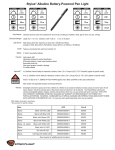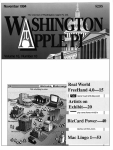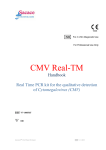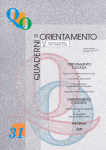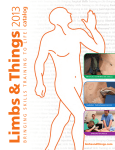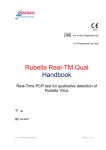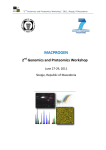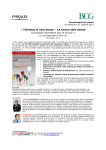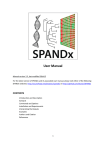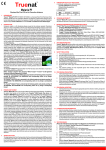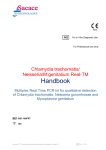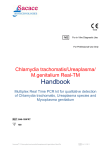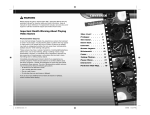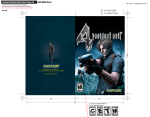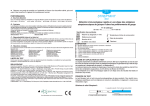Download Toxoplasma gondii Real TM CE
Transcript
For in Vitro Diagnostic Use For Professional Use Only Toxoplasma gondii Real-TM Handbook Real Time PCR kit for qualitative detection of Toxoplasma gondii REF P1-50FRT 50 Sacace™ Toxoplasma gondii Real-TM VER 14.11.2011 NAME Toxoplasma gondii Real – TM INTENDED USE Toxoplasma gondii Real-TM PCR kit is an in vitro nucleic acid amplification test for qualitative detection of Toxoplasma gondii DNA in the clinical material (peripheral blood, umbilical cord blood, white cells of peripheral or umbilical cord blood, biopsy and autopsy material, cerebrospinal fluid, and amniotic fluid) by means of real-time hybridization-fluorescence detection. The results of PCR analysis are taken into account in complex diagnostics of disease. PRINCIPLE OF ASSAY Toxoplasma gondii detection by the polymerase chain reaction (PCR) is based on the amplification of pathogen genome specific region by using specidic primers. In real-time PCR, the amplified product is detected using fluorescent dyes. These dyes are linked to oligonucleotide probes that bind specifically to the amplified product. The real-time monitoring of the fluorescence intensities during the real-time PCR allows the detection of accumulating product without re-opening the reaction tubes after the PCR run. Toxoplasma gondii Real-TM PCR kit uses “hot-start”, which greatly reduces the frequency of nonspecifically primed reactions. “Hot-start” is guaranteed by separation of nucleotides and Taq-polymerase by using chemically modified polymerase (TaqF), which is activated by heating at 95 °C for 15 min. Toxoplasma gondii DNA detection in clinical samples includes: (a) Total DNA extraction from white blood cells of peripheral and umbilical cord blood, biopsy and autopsy material, cerebrospinal fluid, and amniotic fluid simultaneously with the exogenous Internal Control. (b) Multiplex real-time PCR of a DNA fragment of a nonstructural repeated gene (529 bp long) encoding Toxoplasma gondii protein and an artificial DNA fragment cloned into phage λ, which is used as a noncompetitive exogenous Internal Control. Toxoplasma gondii DNA amplification is detected in the JOE/Yellow/HEX/Cy3 channel, the noncompetitive exogenous Internal Control amplification is detected in the FAM/Green channel. The exogenous Internal Control allows monitoring the main steps of PCR analysis (DNA extraction and amplification). The main advantage of a noncompetitive exogenous Internal Control is the extension of the linear detection range and, therefore, an increase in the analytical sensitivity of the test. Sacace™ Toxoplasma gondii Real-TM VER 14.11.2011 MATERIALS PROVIDED Reagent Description Volume, ml Quantity PCR-mix-1-FRT T.gondii colorless clear liquid 0.6 1 tube PCR-mix-2-FRT colorless clear liquid 0.3 1 tube Polymerase (TaqF) colorless clear liquid 0.03 2 tubes Pos Control DNA T. gondii /STI (С+) colorless clear liquid 0.1 1 tube DNA-buffer colorless clear liquid 0.5 1 tube Negative Control (C-)* colorless clear liquid 1.2 1 tube Internal Control STI-87 (IC)** colorless clear liquid 1.0 1 tube * must be used in the isolation procedure as Negative Control of Extraction. ** add 10 µl of Internal Control to each sample during the DNA purification procedure directly to the sample/lysis mixture MATERIALS REQUIRED BUT NOT PROVIDED • DNA extraction kit. • Disposable powder-free gloves and laboratory coat. • Pipettes (adjustable). • Sterile pipette tips with aerosol barriers ( up to 200 µl). • Tube racks. • Vortex mixer. • Desktop centrifuge with a rotor for 2-ml reaction tubes. • PCR box. • Real Time PCR thermocycler (for example, Rotor-Gene 6000/Q (Qiagen), iQ5 (BioRad), Mx3005P (Agilent)). • Disposable polypropylene microtubes for PCR or PCR-plate • Refrigerator for 2–8 °C. • Deep-freezer for ≤ –16 °C. • Waste bin for used tips. PRODUCT USE LIMITATIONS All reagents may exclusively be used in in vitro diagnostics. Use of this product should be limited to personnel trained in the techniques of DNA amplification (EN375). Strict compliance with the user manual is required for optimal PCR results. Attention should be paid to expiration dates printed on the box and labels of all components. Do not use a kit after its expiration date. QUALITY CONTROL In accordance with Sacace’s ISO 13485-Certified Quality Management System, each lot is tested against predetermined specifications to ensure consistent product quality Sacace™ Toxoplasma gondii Real-TM VER 14.11.2011 WARNINGS AND PRECAUTIONS In Vitro Diagnostic Medical Device For In Vitro Diagnostic Use Only 1. Wear disposable gloves, laboratory coats and eye protection when handling specimens and reagents. Thoroughly wash hands afterward. 2. Do not pipette by mouth. 3. Do not eat, drink, smoke, apply cosmetics, or handle contact lenses in laboratory work areas. 4. Do not use a kit after its expiration date. 5. Dispose of all specimens and unused reagents in accordance with local regulations. 6. Biosafety Level 2 should be used for materials that contain or are suspected of containing infectious agents. 7. Clean and disinfect all spills of specimens or reagents using a disinfectant such as 0,5% sodium hypochlorite, or other suitable disinfectant. 8. Avoid contact of specimens and reagents with the skin, eyes and mucous membranes. If these solutions come into contact, rinse immediately with water and seek medical advice immediately. 9. Material Safety Data Sheets (MSDS) are available on request. 10. Use of this product should be limited to personnel trained in the techniques of DNA amplification. 11. PCR reactions are sensitive to contamination. Measures to reduce the risk of contamination in the laboratory include physically separating the activities involved in performing PCR in compliance with good laboratory practice. 12. Workflow in the laboratory must proceed in a uni-directional manner, beginning in the Extraction Area and moving to the PCR and Detection Area. Do not return samples, equipment and reagents in the area where you performed previous step. Some components of this kit contain sodium azide as a preservative. Do not use metal tubing for reagent transfer. Sampling of biological materials for PCR-analysis, transportation, and storage are described in details in the handbook of the manufacturer. It is recommended that this handbook is read before beginning of the work. STORAGE INSTRUCTIONS All components of the Toxoplasma gondii Real-TM PCR kit (except for polymerase (TaqF), PCR-mix-2-FRT, and PCR-mix-1-FRT Toxoplasma gondii) are to be stored at 2– 8 °C. All components of the Toxoplasma gondii Real-TM PCR kit are stable until the expiration date on the label. The shelf life of reagents before and after the first use is the same, unless otherwise stated. Polymerase (TaqF), PCR-mix-2-FRT, and PCR-mix-1-FRT Toxoplasma gondii are to be stored at ≤ –16 °C PCR-mix-1-FRT Toxoplasma gondii is to be kept away from light STABILITY Toxoplasma gondii Real-TM Test is stable up to the expiration date indicated on the kit label. The product will maintain performance through the control date printed on the label. Exposure to light, heat or humidity may affect the shelf life of some of the kit components and should be avoided. Repeated thawing and freezing of these reagents should be avoided, as this may reduce the sensitivity. Components stored under conditions other than those stated on the labels may not perform properly and may adversely affect the assay results. Sacace™ Toxoplasma gondii Real-TM VER 14.11.2011 SAMPLE COLLECTION, STORAGE AND TRANSPORT Toxoplasma gondii Real-TM PCR kit is intended to analyze DNA extracted with DNA extraction kits from: • Whole peripheral and umbilical cord blood • White cells of peripheral or umbilical cord blood • Biopsy and autopsy material • Cerebrospinal fluid • Amniotic fluid • Whole peripheral and umbilical blood. Blood should be collected to a tube with 6% EDTA solution at a ratio 20:1 (20 portions of blood per 1 portion of EDTA) after overnight fasting. Umbilical cord blood is obtained by cordocentesis. Invert the tube several times to ensure proper mixing. Do not freeze the whole blood samples! • White blood cells. Collect 2.5-10 ml blood samples according to standard procedures in tubes containing anticoagulant (recommended anticoagulant is EDTA). Centrifuge samples at ~1500-2000 X g for 10-15 min. This will separate the blood into an upper plasma layer, a lower red blood cell (RBC) layer, and a thin interface containing the WBCs, also called the buffy coat. Remove the plasma with a transfer pipet, being careful not to disturb the WBCs. Samples with exceptionally high WBC counts will have a thicker buffy coat. Use transfer pipet to carefully aspirate the exposed WBC layer in a volume of about 0.5 ml or less. Aspirate slowly, using a circular motion, to pull all the visible buffy coat material into the transfer pipet. Some contamination of the WBCs with the underlying RBCs is expected. Add 300 µl of Solution for Lysis to the tube with the obtained leukocyte sample (for DNA/RNA-Prep protocol). • Biopsy and autopsy material is obtained from the expected location of the pathogen, from the damaged tissue or from the area adjoining with the damaged tissue. Collect the samples to a 2-ml tube with 0.3 ml of transport medium.Transfer the sample to a porcelain mortar; add an equal volume of saline or PBS. Thoroughly homogenize the specimen with a porcelain pestle. Take a 100-µl aliquot and transfer to a sterile tube for DNA extraction. Cerebrospinal fluid should be obtained by the standard procedure and collected to a sterile Eppendorf tube. Amniotic fluid should be obtained during amniocentesis by the standard procedure and collected to a sterile Eppendorf tube. Thoroughly resuspend the obtained sample and transfer 1 ml of it to a new sterile tube. Centrifuge the tube at 8,000– 9,000 g for 10 min. Remove the supernatant leaving 200 µl of the fluid over the pellet. Use tips with aerosol barrier. Resuspend the pellet. • • DNA ISOLATION The following kit is recommended: DNA-Sorb-C (Sacace, REF K-1-6/50): biopsy and autopsy material DNA/RNA-Prep (Sacace, REF K-2-9): whole blood, cerebrospinal fluid, amniotic fluid, white cells Please carry out DNA extraction according to the manufacture’s instruction. Add 10 µl of Internal Control during DNA isolation procedure directly to the sample/lysis mixture. Sacace™ Toxoplasma gondii Real-TM VER 14.11.2011 PROTOCOL (Reaction volume 25 µl): 1. Prepare required quantity of reaction tubes for samples (N) and controls (N+2). 2. Prepare in the new sterile tube for each sample 10*N µl of PCR-mix-1, 5,0*N of PCR-Buffer-FRT and 0,5*N of TaqF Polymerase. Vortex and centrifuge for 2-3 sec. 3. Add 15 µl of Reaction Mix and 10 µl of extracted DNA sample to appropriate tube. Mix by pipetting. (*Re-centrifuge all the tubes with extracted DNA for 2 min at maximum speed (1200016000 g) and take carefully supernatant. N.B. don’t disturb the pellet, sorbent inhibit reaction!). 4. Prepare for each panel 2 controls: • add 10 µl of DNA-buffer to the tube labeled Amplification Negative Control (NCA); • add 10 µl of Toxoplasma gondii C+ to the tube labeled. C+; Toxoplasma gondii on the JOE (Yellow)/HEX/Cy3 channel, IC is detected on the FAM (Green) channel. Amplification Program the real-time instrument according to the manual provided by the manufacturer. Amplification program for rotor-type instruments1 Temperature, Fluorescence Step Time °С detection Hold 95 15 min – 95 5s – Cycling 60 20 s – 72 15 s – 95 5s – FAM/Green, Cycling2 60 20 s JOE/Yellow 72 15 s Repeats 1 5 40 Amplification program for plate-type instruments2 Temperature, Fluorescence Step Time Repeats °С detection 1 95 °С 15 min – 1 95 °С 5s – 2 60 °С 20 s – 5 72 °С 15 s – 95 °С 5s – 3 60 °С 30 s FAM, HEX/Cy3/JOE 40 72 °С 15 s 1 For example Rotor-Gene™ 3000/6000/Q (Corbett Research, Qiagen) 2 For example, iQ5™ (BioRad); Mx3005P™ (Agilent), ABI® 7300/7500/StepOne Real Time PCR (Applied), SmartCycler® (Cepheid), LineGeneK® (Bioer) Sacace™ Toxoplasma gondii Real-TM VER 14.11.2011 INSTRUMENT SETTINGS Rotor-type instruments (RotorGene 3000/6000, RotorGene Q) More Settings/ Channel Threshold Outlier Slope Correct Removal 0.03 10 % On FAM/Green 0.03 10 % On JOE/Yellow Plate-type instruments (iQ5, Mx300P, ABI 7500/7300) Channel Threshold The threshold line should cross only sigmoid curves of signal accumulation of positive samples and should not cross the baseline; FAM otherwise, the threshold level should be raised. Set the threshold at a level where fluorescence curves are linear and do not cross curves of the negative samples. DATA ANALYSIS Toxoplasma gondii DNA amplification product is detected in the JOE/Yellow/HEX channel, Internal Control amplification product is detected in the FAM/Green channel. The results are interpreted by the software of the PCR instrument by the crossing (or not crossing) of the fluorescence curve with the threshold line. The analysis results are considered valid, only if the control samples results comply with the following: Results for controls Control Stage for control NCE NCA C+ DNA extraction Amplification Amplification Ct in channel FAM/Green ≤ 35 Neg ≤ 35 JOE/Yellow/HEX Neg Neg ≤33 Interpretation OK OK OK 1. The sample is considered positive if Ct values detected in the FAM/Green and JOE/Yellow/HEX channel are less than the boundary Ct values (≤ 38) for these channels. The fluorescence curve should have a typical sigmoid shape and cross the threshold line in the region of significant fluorescence increase only once. 2. The sample is considered negative if its fluorescence curve does not cross the threshold line (Ct value is absent) and does not have the typical shape. The results of analysis are considered reliable only if the results obtained for Positive and Negative Controls of Amplification as well as for the Negative Control of Extraction are correct. QUALITY CONTROL PROCEDURE A defined quantity of Internal Control (IC) is introduced into each sample and control at the beginning of sample preparation procedure in order to control the extraction process of each individual sample and to identify possible reaction inhibition. A negative control of extraction (NCE), negative amplification control (NCA), positive amplification control (C+) are required for every run to verify that the specimen preparation, the amplification and the detection steps are performed correctly. If the controls are out of their expected range (see table Results for Controls), all of the specimens and controls from that run must be processed beginning from the sample preparation step. Sacace™ Toxoplasma gondii Real-TM VER 14.11.2011 PERFORMANCE CHARACTERISTICS Sensitivity The analytical sensitivity of Toxoplasma gondii Real-TM PCR kit is 400 Toxoplasma gondii DNA copies/ml. The claimed analytical features of Toxoplasma gondii Real-TM PCR kit are guaranteed only when additional reagent kit (DNA/RNA-prep or DNA-sorb-C) is used. Specificity The analytical specificity of Toxoplasma gondii Real-TM PCR kit is ensured by selection of specific primers and probes as well as stringent reaction conditions. The primers and probes were checked for possible homologies to all sequences published in gene banks by sequence comparison analysis. The clinical specificity of Toxoplasma gondii Real-TM PCR kit was confirmed in laboratory clinical tests. Target region: 529bp tandem repeat TROUBLESHOOTING 1. Weak or absent signal of the IC (Fam/Green): retesting of the sample is required. • The PCR was inhibited. ⇒ Make sure that you use a recommended DNA extraction method and follow the manufacturer’s instructions. ⇒ Re-centrifuge all the tubes before pipetting the extracted DNA for 2 min at maximum speed (12000-16000 g) and take carefully supernatant. Don’t disturb the pellet, sorbent inhibit reaction. • The reagents storage conditions didn’t comply with the instructions. ⇒ Check the storage conditions • The PCR conditions didn’t comply with the instructions. ⇒ Check the PCR conditions and for the IC detection select the fluorescence channel reported in the protocol. • Improper DNA extraction. ⇒ Repeat analysis starting from the DNA extraction stage • The IC was not added to the sample during the pipetting of reagents. ⇒ Make attention during the DNA extraction procedure. 2. Weak (Ct > 38) signal on the Joe (Yellow)/Cy3/HEX channel: the result is considered equivocal. It is necessary to repeat the analysis twice. If a positive Ct value is detected twice, the sample is considered as positive. 3. Joe (Yellow)/Cy3/HEX signal with Negative Control of extraction. • Contamination during DNA extraction procedure. All samples results are invalid. ⇒ Decontaminate all surfaces and instruments with sodium hypochlorite and ethanol. ⇒ Use only filter tips during the extraction procedure. Change tips among tubes. ⇒ Repeat the DNA extraction with the new set of reagents. 4. Any signal with Negative PCR Control. • Contamination during PCR procedure. All samples results are invalid. ⇒ Decontaminate all surfaces and instruments with sodium hypochlorite and ethanol or special DNA decontamination reagents. ⇒ Pipette the Positive controls at the end. ⇒ Repeat the PCR preparation with the new set of reagents. Sacace™ Toxoplasma gondii Real-TM VER 14.11.2011 REFERENCES • Detection of Toxoplasma gondii by PCR and tissue culture in cerebrospinal fluid and blood of human immunodeficiency virus-seropositive patients. Dupon, M. et al. J Clin Microbiol 1995: 33:2421-2426. • Diagnosis of Toxoplasma parasitemia in patients with AIDS by gene detection after amplification with polymerase chain reaction. Filice, GA. et al. J Clin Microbiol 1993; 31:2327-2331. • PCR detection of Toxoplasma gondii DNA in CSF for the differential diagnosis of AIDS-related focal brain lesions. Antonella Cingolani, Andrea De Luca, Adriana Ammassari, Rita Murri, Angela Linzalone, Rita Grillo* and Andrea Antinori. J Med Microbiol December 1996 vol. 45 no. 6 472476 • Real-Time PCR for Quantitative Detection of Toxoplasma gondii. Mei-Hui Lin,1 Tse-Ching Chen,2 Tseng-tong Kuo,2 Ching-Chung Tseng,3 and Ching-Ping Tseng1, Journal of Clinical Microbiology, November 2000, p. 4121-4125, Vol.38, No.11 • Detection of Toxoplasma gondii in cerebrospinal fluid from AIDS patients by polymerase chain reaction. S F Parmley, F D Goebel and J S Remington J Clin Microbiol. 1992 November; 30(11): 30003002 • • The detection of Toxoplasma gondii by comparing cytology, histopathology, bioassay in mice, and the polymerase chain reaction (PCR) Aristeu Vieira da Silva, Helio Langoni. Veterinary Parasitology, Volume 97, Issue 3, 12 June 2001, Pages193-200 • Detection by PCR of Toxoplasma gondii in blood in the diagnosis of cerebral toxoplasmosis in patients with AIDS.J Lamoril, J M Molina, A de Gouvello, Y J Garin, J C Deybach, J Modaï, F Derouin J Clin Pathol 1996;49:89-92 doi:10.1136/jcp.49.1.8 Sacace™ Toxoplasma gondii Real-TM VER 14.11.2011 KEY TO SYMBOLS USED List Number Caution! Lot Number Contains sufficient for <n> tests For in Vitro Diagnostic Use Version Store at NCA Negative Control of Amplification Manufacturer C– Negative control of Extraction Consult instructions for use C+ Positive Control of Amplification Expiration Date Sacace™ Toxoplasma gondii Real-TM IC Internal Control VER 14.11.2011 NOTE Sacace™ Toxoplasma gondii Real-TM VER 14.11.2011 *iQ5™ is a registered trademark of Bio-Rad Laboratories * Rotor-Gene™ Technology is a registered trademark of Qiagen * MX3005P® is a registered trademark of Agilent Technologies *ABI® is a registered trademark of Applied Biosystems * LineGeneK® is a registered trademark of Bioer * SmartCycler® is a registered trademark of Cepheid Sacace Biotechnologies Srl via Scalabrini, 44 – 22100 – Como – Italy Tel +390314892927 Fax +390314892926 mail: [email protected] web: www.sacace.com Sacace™ Toxoplasma gondii Real-TM VER 14.11.2011












